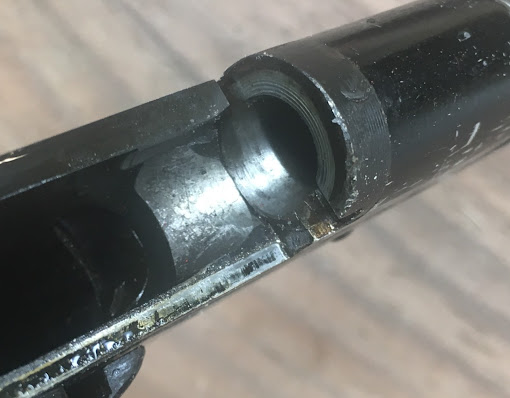I've been thinning out my collection, getting rid of guns I didn't actually shoot. The last thing I needed was another Soviet-era European pistol... and then I saw that Classic Firearms had received a shipment of FEG AP7.65 pistols... and was selling them at an attractive price. Hmm. I rationalized that I'd sold 5 guns this year and was planning on selling a few more, so there was room in the safe. Plus this pistol had several things going for it:
- It was in 7.65 Browning, aka .32ACP, and I'd never owned a pistol in that caliber.
- It was based on the Walther PP.
- It has the classic sculpted lines that have disappeared in modern firearms.
- It was only $219.
I ordered one and had it shipped to my local FFL I also opted to spend an additional $20 for special hand selection, which I think paid off:
The slide is in excellent condition, with no scratches or wear to the bluing. The only real wear on the gun is that seen on the barrel through the ejection port. The frame also shows some wear, but that could be expected as the anodized surface isn't as hard as the blued steel slide.
While waiting for the pistol to arrive I did the usual Google searches to learn some more about the gun, and discovered that there's some confusion out there as to the history of the gun. Classic Arms stated that these were police turn-ins, but that may or may not be the case. For one thing, countries under Soviet rule were generally constrained to using pistols firing the 9x18 Makarov, and either used the Russian pistol or developed their own gun in that caliber. The standard Hungarian police gun, developed to accommodate that mandate, was the Reddõrségi Pistoly R61, in 9x18 Makarov, which was based on the Walther PP. A commercial version was also sold in .380 (or 9mm Browning, as it is known in Europe.)
The success of the R61 led to the a request by the Hungarian military for a similar lightweight pistol, and FEG responded with the PA-63, in 9mm Makarov (Piztoly 63 Minta, or PS-63M). This served as the primary army pistol until the collapse of the Soviet Union, at which time it was replaced by the P93 in NATO standard 9MM Parabellum. That in turn led to the development of a variant of the PA-63, the AP7.65, as an export model.
Some commenters in forums claim that some of these AP7.65s were used by Hungarian police departments, perhaps in an unofficial capacity. Others stare that these were used by paramilitaries, border guards, or other security forces. One source says that they came from Israel, where they were used by the civil police, the Mishteret Yisroel. Leaving that question aside, let's get back to the details of the gun itself.
The AP7.75 has a steel slide assembly and an aluminum-titanium alloy frame that can be found today in two different cosmetic versions. Mine, as you can see, has a blue or blue-black anodized finish, but it's also available in a "two toned" versions, with a reddish or yellowish anodized frame. I had a choice, and opted for blue, in part because I think it looks better ( and in part because they wanted an extra $20 for the color anodized versions.)
As noted earlier, it's based on the classic Walther PP- but with a very well thought out safety improvements by FEG. Both the FEG and Walther have a hammer block safety that's part of the safety/decocking lever, but the FEG adds a further firing pin safety to the PA-63. If you look at the firing pin of an AP7.65 or PA-63,, you'll note that the firing pin doesn't actually line up with the firing pin. It's only when you pull the trigger (or pull the hammer back on a fully cocked gun) that you'll see the firing pin tilt up so that it's in line with the hammer. That makes cocking very safe. Even if the hammer block fails, the gun will not fire.
Disassembly is identical to that of the PP series. It begins by pulling down on the trigger guard, which is hinged at the rear\. Pulling it to one side prevents it from springing back into the frame.
See that lug that goes into the frame when the trigger guard is in it's normal position? That stops the slide in its rearward travel under recoil. Once the trigger guard is out of the way, the slide can be pulled beyond its normal travel, the rear of the slide lifted to clear the rails it travels on, and then slid forward and off the gun:
Something I learned after first posting this article: The grips with the thumb rest were not a feature of the pistol originally, and were added for the US market. The reason for that dates back to the 1968 GCA, which established a points system to determine if a gun could be legally imported. The given reason was to ban small, inexpensive guns with "no sporting use." The thumb rest grips are considered a feature of target pistols. Some shooters don't like these, and replacements are available- including original grips removed when these were substituted.
The bore was clean and shiny, and the ramp showed signs of either oil that had hardened from polymerization, or or perhaps some leftover cosmoline-type coating.
Part 2 will be about actually firing the AP7.65, but that'll have to wait until (1) I find some .32ACP at a reasonable price and (2) I get to the range. Given that it's almost deer season, and everyone who hasn't fired their gun since last year is lining up to zero and practice, it may be a while before I get there.






No comments:
Post a Comment